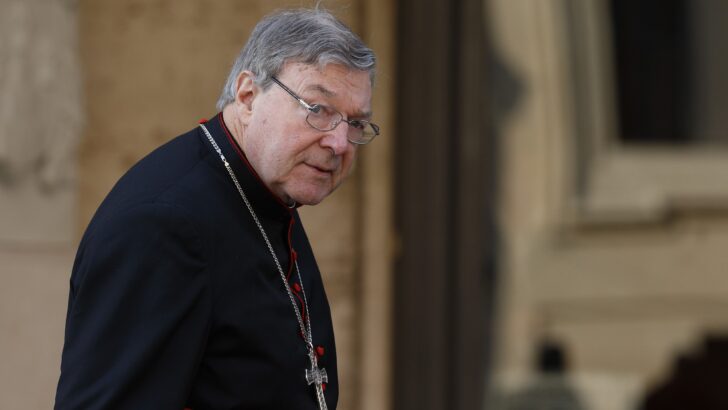Editorial
In his Prison Journal, Cardinal George Pell offers a sobering yet steadfast reflection on the state of the Catholic Church, particularly in Australia and the West. His observations, written in the solitude of his prison cell, are not those of a man bitterly lamenting the Church’s struggles but of one who sees hope in fidelity to tradition. Pell argues that true renewal comes not from innovation for innovation’s sake but from a firm commitment to faith, prayer, and orthodoxy. His reflections resonate far beyond his personal situation, offering a clarion call to a Church at a crossroads.
Pell acknowledges the difficult reality: “We have been in the lean years, and prayer, orthodoxy, and loyalty cannot guarantee genuine growth” – an admission that faithfulness does not automatically translate to flourishing numbers. Yet, he insists that abandoning these foundations is no solution. “We have to be united to the vine, and we will certainly not nourish genuine vitality without faith, prayer, and sacrifice.” This assertion strikes at the heart of contemporary debates within Catholicism, where some argue that doctrinal flexibility and modernisation are the keys to reversing decline. Pell sees this as misguided, pointing to historical examples of what happens when the Church loses its identity.
The decline of Catholicism in places like Quebec, Holland, and Belgium serves as a cautionary tale. He warns that the upcoming Australian Plenary Council 2020, if handled poorly, could accelerate the Church’s collapse. “Too many, even some bishops, are too reconciled to decline, and some do not even know where the battlefield is.” This indictment of clerical complacency is a striking critique. Pell does not shy away from the reality that some in leadership positions fail to grasp the existential challenges facing the Church.
Yet, amid these challenges, he sees hope – not in bureaucratic restructuring or doctrinal experimentation, but in the young priests, religious, and laity who remain committed to the faith as it has been handed down. “The young priests, the young women religious (to the extent we have them) are faithful, prayerful, and know where the main game is to be played.” Similarly, he notes that “the smaller number of regularly worshipping young adults are faithful and prayerful.” This observation aligns with global trends: where Catholicism is thriving, it is often due to adherence to tradition rather than compromise with secular culture.
Pell’s reflections on the aftermath of Vatican II further illuminate his perspective. He describes how, in the post-conciliar period, many assumed that being “progressive” meant supporting reforms beyond the texts of the Council itself. He recalls how theologians like Joseph Ratzinger, Henri de Lubac, and Hans Urs von Balthasar helped clarify the choice between “continuity or rupture.” For Pell, the lesson is clear: genuine reform must be anchored in the authentic teachings of the Church rather than serve as a pretext for radical departures.
His reflections are not purely theoretical. They are deeply personal. He expresses gratitude for the many letters he receives from Catholics thanking him for his efforts to strengthen faith in the community. “God gives the increase, but the moves were well-intentioned and, I deeply believe, coherent and consistent with the only strategies that might produce growth.” His faith in the power of God’s grace underlines his belief that renewal does not come from human strategies alone but through fidelity to Christ and His Church.
Pell’s reflections also touch on the importance of personal holiness and perseverance. He finds solace in the words of St Thérèse of Lisieux, who compared prayer – even when hindered by fatigue – to a child resting in a parent’s arms. This humble acknowledgment of human weakness reinforces his broader message: the Church’s renewal will not come from activism alone but from deep spiritual commitment.
In his closing reflections, Pell prays for discernment among Church leaders, quoting James McAuley’s poetic plea: “Set pools of (prayerful) silence in this thirsty land.” He does not call for revolution but for a return to the wellspring of Catholic faith – prayer, tradition, and sacrifice. His message is both a challenge and an encouragement to Catholics today: do not seek shortcuts, do not fear being countercultural, and do not abandon the rich inheritance of the faith.
As debates continue over the future of the Church, Pell’s reflections stand as a reminder that renewal does not mean reinvention. His Prison Journal is not merely the musings of a man enduring hardship but a profound meditation on what it means to be faithful in times of crisis. The Church, he insists, must remain “united to the vine.” If it does, true growth – spiritual and even numerical – will follow.
Faithfulness in the face of decline: Cardinal Pell’s call to the Catholic Tradition
 Australian Cardinal George Pell is pictured during the extraordinary Synod of Bishops on the family at the Vatican on October 6, 2014. Photo: CNS
Australian Cardinal George Pell is pictured during the extraordinary Synod of Bishops on the family at the Vatican on October 6, 2014. Photo: CNS 

